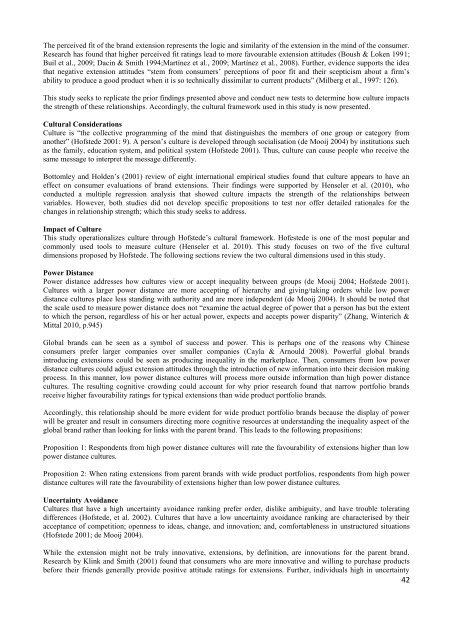Brand, Identity and Reputation: Exploring, Creating New Realities ...
Brand, Identity and Reputation: Exploring, Creating New Realities ...
Brand, Identity and Reputation: Exploring, Creating New Realities ...
You also want an ePaper? Increase the reach of your titles
YUMPU automatically turns print PDFs into web optimized ePapers that Google loves.
The perceived fit of the br<strong>and</strong> extension represents the logic <strong>and</strong> similarity of the extension in the mind of the consumer.<br />
Research has found that higher perceived fit ratings lead to more favourable extension attitudes (Boush & Loken 1991;<br />
Buil et al., 2009; Dacin & Smith 1994;Martínez et al., 2009; Martínez et al., 2008). Further, evidence supports the idea<br />
that negative extension attitudes ―stem from consumers‘ perceptions of poor fit <strong>and</strong> their scepticism about a firm‘s<br />
ability to produce a good product when it is so technically dissimilar to current products‖ (Milberg et al., 1997: 126).<br />
This study seeks to replicate the prior findings presented above <strong>and</strong> conduct new tests to determine how culture impacts<br />
the strength of these relationships. Accordingly, the cultural framework used in this study is now presented.<br />
Cultural Considerations<br />
Culture is ―the collective programming of the mind that distinguishes the members of one group or category from<br />
another‖ (Hofstede 2001: 9). A person‘s culture is developed through socialisation (de Mooij 2004) by institutions such<br />
as the family, education system, <strong>and</strong> political system (Hofstede 2001). Thus, culture can cause people who receive the<br />
same message to interpret the message differently.<br />
Bottomley <strong>and</strong> Holden‘s (2001) review of eight international empirical studies found that culture appears to have an<br />
effect on consumer evaluations of br<strong>and</strong> extensions. Their findings were supported by Henseler et al. (2010), who<br />
conducted a multiple regression analysis that showed culture impacts the strength of the relationships between<br />
variables. However, both studies did not develop specific propositions to test nor offer detailed rationales for the<br />
changes in relationship strength; which this study seeks to address.<br />
Impact of Culture<br />
This study operationalizes culture through Hofstede‘s cultural framework. Hofestede is one of the most popular <strong>and</strong><br />
commonly used tools to measure culture (Henseler et al. 2010). This study focuses on two of the five cultural<br />
dimensions proposed by Hofstede. The following sections review the two cultural dimensions used in this study.<br />
Power Distance<br />
Power distance addresses how cultures view or accept inequality between groups (de Mooij 2004; Hofstede 2001).<br />
Cultures with a larger power distance are more accepting of hierarchy <strong>and</strong> giving/taking orders while low power<br />
distance cultures place less st<strong>and</strong>ing with authority <strong>and</strong> are more independent (de Mooij 2004). It should be noted that<br />
the scale used to measure power distance does not ―examine the actual degree of power that a person has but the extent<br />
to which the person, regardless of his or her actual power, expects <strong>and</strong> accepts power disparity‖ (Zhang, Winterich &<br />
Mittal 2010, p.945)<br />
Global br<strong>and</strong>s can be seen as a symbol of success <strong>and</strong> power. This is perhaps one of the reasons why Chinese<br />
consumers prefer larger companies over smaller companies (Cayla & Arnould 2008). Powerful global br<strong>and</strong>s<br />
introducing extensions could be seen as producing inequality in the marketplace. Then, consumers from low power<br />
distance cultures could adjust extension attitudes through the introduction of new information into their decision making<br />
process. In this manner, low power distance cultures will process more outside information than high power distance<br />
cultures. The resulting cognitive crowding could account for why prior research found that narrow portfolio br<strong>and</strong>s<br />
receive higher favourability ratings for typical extensions than wide product portfolio br<strong>and</strong>s.<br />
Accordingly, this relationship should be more evident for wide product portfolio br<strong>and</strong>s because the display of power<br />
will be greater <strong>and</strong> result in consumers directing more cognitive resources at underst<strong>and</strong>ing the inequality aspect of the<br />
global br<strong>and</strong> rather than looking for links with the parent br<strong>and</strong>. This leads to the following propositions:<br />
Proposition 1: Respondents from high power distance cultures will rate the favourability of extensions higher than low<br />
power distance cultures.<br />
Proposition 2: When rating extensions from parent br<strong>and</strong>s with wide product portfolios, respondents from high power<br />
distance cultures will rate the favourability of extensions higher than low power distance cultures.<br />
Uncertainty Avoidance<br />
Cultures that have a high uncertainty avoidance ranking prefer order, dislike ambiguity, <strong>and</strong> have trouble tolerating<br />
differences (Hofstede, et al. 2002). Cultures that have a low uncertainty avoidance ranking are characterised by their<br />
acceptance of competition; openness to ideas, change, <strong>and</strong> innovation; <strong>and</strong>, comfortableness in unstructured situations<br />
(Hofstede 2001; de Mooij 2004).<br />
While the extension might not be truly innovative, extensions, by definition, are innovations for the parent br<strong>and</strong>.<br />
Research by Klink <strong>and</strong> Smith (2001) found that consumers who are more innovative <strong>and</strong> willing to purchase products<br />
before their friends generally provide positive attitude ratings for extensions. Further, individuals high in uncertainty<br />
42
















